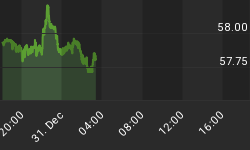Here is an extract from commentary posted at A game of chicken Weve currently got gold and commodity prices rising, long-term interest rates trending higher after making a major bottom a few months ago, the US$ falling, and a gaggle of Federal Reserve representatives taking every opportunity to assure us that short-term interest rates are going to be maintained at current low levels for the foreseeable future. In fact, a few weeks ago Fed Governor Bernanke went so far as to say that short-term interest rates would continue to be pegged at a low level by the Fed even if the economic growth rate began to accelerate higher because higher economic growth at this time probably wouldn't create significant employment growth. In other words, Greenspan and Co. are telling us they won't raise short-term interest rates in order to prevent the US dollar or US bonds from falling. This is clearly not true because if the US$ continues to fall and, in particular, if long-term interest rates continue to rise, a point will eventually be reached where they will be forced to do something in order to avoid a total rout in US financial assets. What they are doing at the moment, therefore, is playing a dangerous game of chicken with the markets. They are effectively seeing how much they can allow inflation fears to build without losing all semblance of control over the eventual outcome.
We have to like gold and dislike the US$ in the current environment. It is one thing to bet against the ability of the Bank of Japan to engineer a weak Yen when natural market forces are pushing the Yen higher. It is another thing altogether to bet against the ability of the Fed to engineer a weak dollar, if this is what it really wants, when natural market forces are tending to push the dollar lower. As discussed above and in previous commentaries, though, a time will come when additional dollar weakness will no longer be acceptable to policy-makers regardless of what statements these policy-makers have made in the past about maintaining short-term interest rates at a low level. This is why we need to pay more attention to the markets than to the words of Federal Reserve officials. The markets are likely to signal a change in monetary policy well before policy-makers begin to publicly hint that such a change might be necessary.
Bonds and the Dollar
Bonds and the US$ have consistently moved in opposite directions over the past few years with this inverse relationship being particularly obvious over the past 6 months. Our theory has been, and continues to be, that foreign central banks have been instrumental in creating this strong negative correlation between the US$ and US bonds. Specifically, foreign central banks (the BOJ being the main offender) have intervened in the currency market whenever the dollar has weakened in an attempt to prevent their own currencies from becoming too strong. The dollars that have been purchased in such interventions have typically been invested in US Government or Agency debt securities, thus boosting the prices of these securities. The weaker the dollar became the more dollars and, therefore, the more bonds, were purchased by the BOJ et al. Correspondingly, during those periods when the dollar has strengthened there hasn't been a need for foreign central banks to buy dollars and one of the largest components of the demand for US bonds has disappeared, thus causing bond prices to fall.
But what happens now that the BOJ and other G7 central banks have agreed that a flexible currency rate is desirable in order to help smooth out economic ups and downs? This, in essence, means that the major central banks have agreed to allow the dollar to fall, which will, if our theory is correct, substantially reduce the demand for US bonds.
Now, we doubt that the Japanese will fully comply with the agreement reached at last weekend's G7 meeting because when push comes to shove local politics will always come first. However, it is likely that the BOJ won't support the US$ as aggressively in the future as it has done in the past. This, in turn, opens the door for large concurrent declines in US bonds and the US$ beginning late this year. Note that this is something that would have happened anyway, but with central banks vowing to stand aside and let the markets work it might happen more quickly than would otherwise have been the case. These concurrent declines in the US dollar and US bonds will, we think, prompt an about-face in US monetary policy during the first half of next year.
















